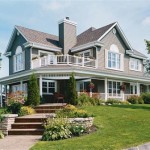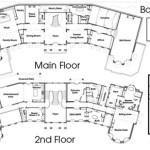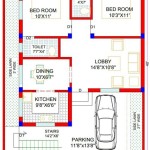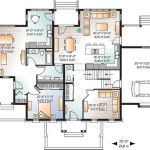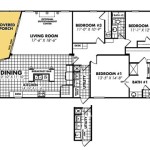Understanding Big House Floor Plans: Maximizing Space and Functionality
Big houses, often defined as homes exceeding 3,000 square feet, present unique considerations in architectural design and floor plan development. These expansive residences require careful planning to ensure efficient use of space, comfortable living, and effective flow between different areas. A well-designed floor plan is crucial for transforming a large dwelling from a collection of rooms into a cohesive and functional home.
Designing for large spaces differs significantly from planning smaller residences. The scale of the house necessitates a focus on proportion, layout, and connectivity to prevent a feeling of emptiness or disjointedness. Common issues include awkward room arrangements, inefficient traffic patterns, and a lack of visual appeal. Therefore, a strategic approach is essential to creating a big house that is both aesthetically pleasing and practical for everyday living.
Key Considerations in Big House Floor Plan Design
The development of a successful floor plan for a large house requires consideration of several factors. These include the lifestyle of the occupants, the specific features desired, and the overall design aesthetic. Prioritizing these elements in the planning process leads to a home that is tailored to its inhabitants and optimized for comfort and functionality.
One of the initial steps is to define the functional zones within the house. This involves grouping related activities and spaces together, such as the living areas (living room, dining room, kitchen), private areas (bedrooms, bathrooms), and service areas (laundry room, garage). Zoning helps to create a logical flow within the house and ensures that each area serves its intended purpose efficiently.
Consideration should also be given to the natural light within the house. Orienting the house to maximize sunlight exposure can significantly impact the comfort and energy efficiency of the home. Strategic placement of windows and skylights can brighten interior spaces and reduce the need for artificial lighting during the day.
Furthermore, the exterior design of the house should complement the floor plan. The architectural style of the house, including the roofline, façade, and landscaping, should be in harmony with the interior layout. A cohesive design approach ensures that the house is not only functional but also visually appealing from both the inside and outside.
Essential Spaces and Their Placement in Big House Plans
Big houses typically include a range of spaces, each with its own unique requirements. The arrangement of these spaces within the floor plan is crucial for creating a functional and comfortable home. Understanding the specific needs of each area is essential for optimizing its design.
The living areas, including the living room, dining room, and kitchen, are often considered the heart of the home. These spaces should be designed to accommodate both everyday activities and social gatherings. An open-concept layout is a popular choice for these areas, as it promotes connectivity and allows for easy interaction between family members and guests. The kitchen, in particular, should be designed with ample counter space, storage, and efficient workflow to facilitate meal preparation.
The private areas, such as the bedrooms and bathrooms, should be located in a quiet and secluded part of the house. The master suite, in particular, should be designed as a retreat, with features such as a spacious bedroom, walk-in closet, and luxurious bathroom. Guest bedrooms should be located away from the master suite to provide privacy for both the occupants and their guests. Sufficiently sized bathrooms with appropriate fixtures are crucial for comfort and convenience.
Service areas, including the laundry room, mudroom, and garage, should be located in areas that are easily accessible but do not interfere with the main living spaces. The laundry room should be equipped with ample counter space for folding clothes and storage for laundry supplies. The mudroom should provide a transition space between the outdoors and the indoors, with storage for shoes, coats, and other outdoor gear. The garage should be large enough to accommodate vehicles and other equipment, with direct access to the house for convenience.
Additional spaces that are often included in big houses include home offices, media rooms, game rooms, and home gyms. These spaces should be designed to meet the specific needs and interests of the occupants. A home office should provide a quiet and productive workspace, while a media room should be designed to create an immersive entertainment experience. Game rooms and home gyms should be designed with appropriate equipment and space for recreational activities.
Optimizing Flow and Connectivity in Large Residences
Flow and connectivity are essential elements of a successful big house floor plan. A well-designed layout should allow for easy movement between different areas of the house and create a sense of cohesiveness and harmony. Poor flow can lead to awkward traffic patterns, wasted space, and a feeling of disconnect between different parts of the house.
One of the key strategies for optimizing flow is to create clear and direct pathways between different areas of the house. This can be achieved by minimizing the number of hallways and creating open-concept spaces that seamlessly connect different rooms. Wide doorways and hallways can also help to improve flow and make the house more accessible for people with mobility issues.
Another important consideration is the placement of stairs. Stairs should be located in a central area of the house to provide easy access to all levels. The design of the stairs should be both functional and aesthetically pleasing, with features such as a comfortable rise and run, adequate lighting, and a visually appealing railing.
Connectivity can also be enhanced through the use of visual cues and design elements that create a sense of continuity between different spaces. This can be achieved through the use of consistent color palettes, flooring materials, and architectural details throughout the house. Large windows and doors can also help to connect the interior spaces with the outdoor environment, creating a sense of openness and spaciousness.
Furthermore, the use of furniture and accessories can also play a role in optimizing flow and connectivity. Furniture should be arranged in a way that facilitates movement and encourages interaction. Area rugs can be used to define different zones within a large space and create a sense of separation between different activities. Art and decorative objects can be used to add visual interest and create a sense of personality and style throughout the house.
In conclusion, designing a floor plan for a big house requires careful planning and consideration of various factors. By focusing on functionality, flow, and connectivity, it is possible to create a large residence that is both comfortable and aesthetically pleasing. A well-designed floor plan can transform a large dwelling into a true home, where occupants can live, work, and play in style and comfort.
The importance of consulting with experienced architects and interior designers cannot be overstated. These professionals possess the knowledge and expertise to guide homeowners through the complex process of designing a big house floor plan. Their insights can help to ensure that the final design meets the specific needs and preferences of the occupants, while also maximizing the potential of the space.
Ultimately, the goal of a big house floor plan should be to create a space that is not only large but also livable. A well-designed floor plan should facilitate everyday activities, encourage social interaction, and provide a sense of comfort and security. When these elements are successfully integrated, a big house can become a truly exceptional place to call home.

House Plands Big Floor Plan Large Images For Su Plans Американские дома Планы этажей Планировки

2 Story Modern House Plans Houseplans Blog Com

Large House Plan Examples

Unique Two Story House Plan Floor Plans For Large 2 Homes Desi Design Blueprints

4 Bedroom Tropical Style Two Story Home

Floorplan

Modern Open Floor House Plans Blog Eplans Com

Big Five Bedroom House Plans Blog Dreamhomesource Com

Spacious And Open Best Floor Plans For Families Blog Homeplans Com

House Plan 3rd 335 15 Plans Dream Floor


